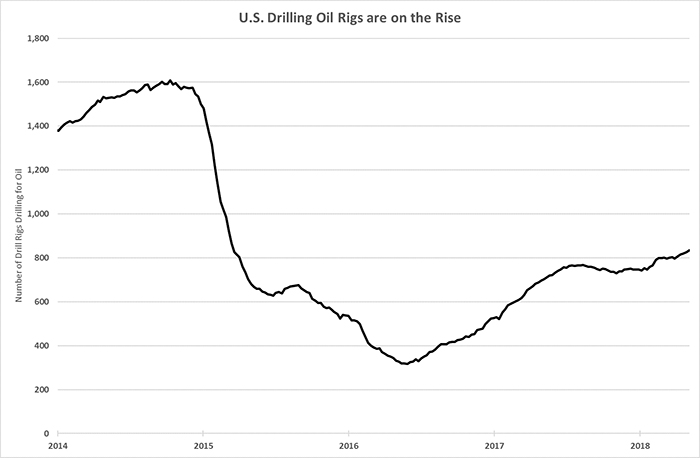There is a simple way to gauge the health of the oil patch: the number of drill rigs operating.
During the boom years, I would fly to West Texas and drive around the Permian Basin. Back then, it was the up-and-coming shale play.
In the boom, you could see drill rig tops dotting the landscape.
When I went back in 2016, at a time when the oil price broke through $40 per barrel on its way down, you could still see drilling rigs. But they were all parked in “boneyards.”
These rigs worked 24 hours per day only months before. By early 2016, they sat rusting in huge, weedy fields.
The Drill Rigs Are Back to Work
From October 2014 to May 2016, the number of rigs drilling for oil in the U.S. fell 80%.
At the bottom, there were just 316 drilling rigs looking for oil in the U.S. Those rigs drilled wells simply to meet obligations — where a company had to drill a well or face losing its rights to the land.
You can see what I mean from the chart of the Baker Hughes Rig Count below:

However, as oil prices edged higher, the number of working rigs climbed.
As you can see, the rig count climbed to 834 in the first week of May. That’s a 164% increase in drill rigs in two years. However, with oil prices over $70 per barrel, I expect that to change rapidly.
The Oil Market Is About to Explode
The price of oil is nearly 200% higher today than it was at the bottom in 2016.
Oil companies, wary of a return to low prices, didn’t plan much drilling in 2017. However, the situation changed since then.
The oil market tightened up. As I told you back in March, Venezuela’s oil production is in serious decline. The supply loss, combined with rising demand in Europe and Asia, put oil prices back in question.
We can no longer assume that U.S. shale production will keep prices low. That story doesn’t work anymore. And with the U.S. now returning sanctions on Iran, the oil market is about to explode.
We could easily see oil prices spike to $100 per barrel on bad news.
Protect Yourself Against Higher Oil Prices
While this isn’t a guaranteed scenario, investors should hold some oil companies in their portfolio. And the best way to add exposure to the oil sector today is a play on more drill rigs.
A simple exchange-traded fund (ETF) like the VanEck Vectors Oil Services ETF (NYSE: OIH) is a great way to play the rapid expansion of drilling in the U.S.
However, another simple way to play rising oil prices is through the SPDR S&P Oil & Gas Exploration & Production ETF (NYSE: XOP).
This speculation is all about offsetting higher prices. If the oil price goes up, it’ll cost us more — more for gasoline, more for services, more for travel.
Taking a position in oil right now is a good way to protect yourself against higher prices down the road.
Good investing,

Matt Badiali
Editor, Real Wealth Strategist




